Relocate beehives instead of exterminating them, urge rescuers
Sign up now: Get ST's newsletters delivered to your inbox
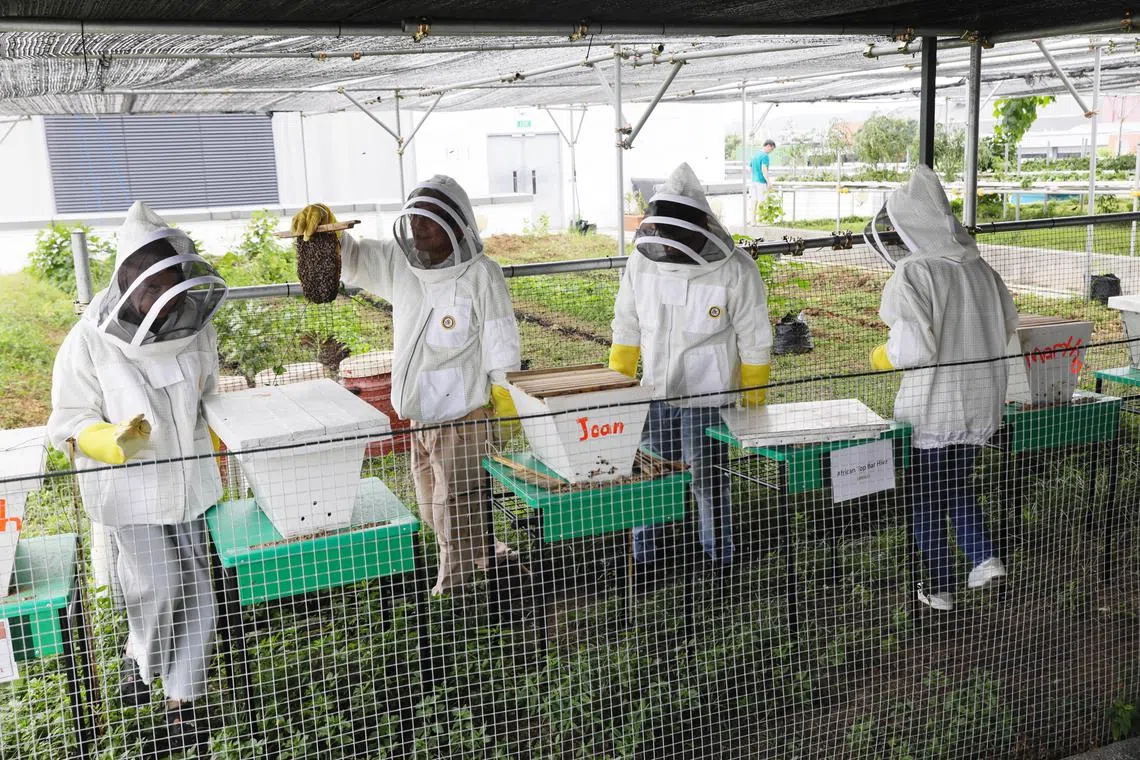
Bee Amazed Garden founder John Chong (holding the nest of Asian honey bees) introducing three SUSS students to the bee sanctuary in the university.
ST PHOTO: KELVIN CHNG
Follow topic:
SINGAPORE – There is a row of about 10 distinctly shaped boxes in a rooftop farm at the Singapore University of Social Sciences (SUSS).
And one would have to peer closely at them to see what is happening: small clusters of worker bees crawling around and guarding the entrance to their homes.
Since any buzzing is rarely heard, it is hard to believe that some of the boxes collectively house about 100,000 Asian honey bees, the most common bee species in Singapore.
The bees were rescued from extermination and relocated from urban areas by Mr John Chong, founder and beekeeper at Bee Amazed Garden – a beekeeping and education firm.
After Bee Amazed was asked in 2022 to vacate its premises in Yishun as the area was slated for redevelopment, Nutrious Farms, which manages the rooftop farm at SUSS, offered Mr Chong a space for his bees a few months ago.
He has been quietly taking care of his bees at the university since March. He is now designing a continuing education and training (CET) course on beekeeping for SUSS, to help students lose their fear of the insects and train pest control workers in bee rescue.
“Bees are not the way movies and cartoons portray them. They are not monsters out to harm us. The students will also learn about how bees help with food security,” said Mr Chong, a former educator.
SUSS students and staff are unlikely to see swarms of bees flying around on campus as most of them are busy working in their hives.
“Foraging bees are very targeted. They will go straight to the flowers and nectar, and return. Their range is up to 4km. Clementi Forest, which is near SUSS, would be one of their sources,” said Mr Chong.
In late May, 30 SUSS students worked with Bee Amazed as part of a corporate event hosted by the university.
Third-year marketing student Lim Li Shian, 24, was initially frightened when she stepped into the sanctuary with her protective gear.
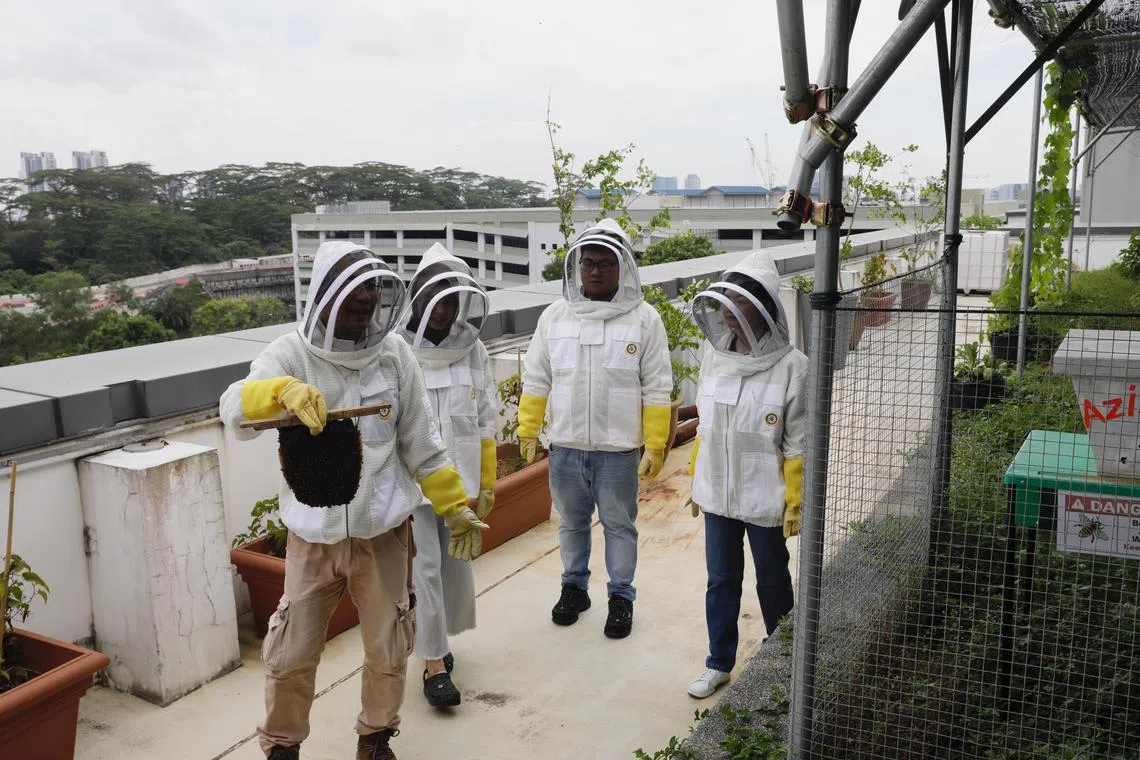
Bee Amazed Garden founder John Chong (left) introducing Ms Lim Li Shian (right) and other SUSS students to the bee sanctuary.
ST PHOTO: KELVIN CHNG
“When (Mr Chong) took the bees out, I thought they would start swarming. But I realised they were quite gentle and stayed in their nest,” said Ms Lim.
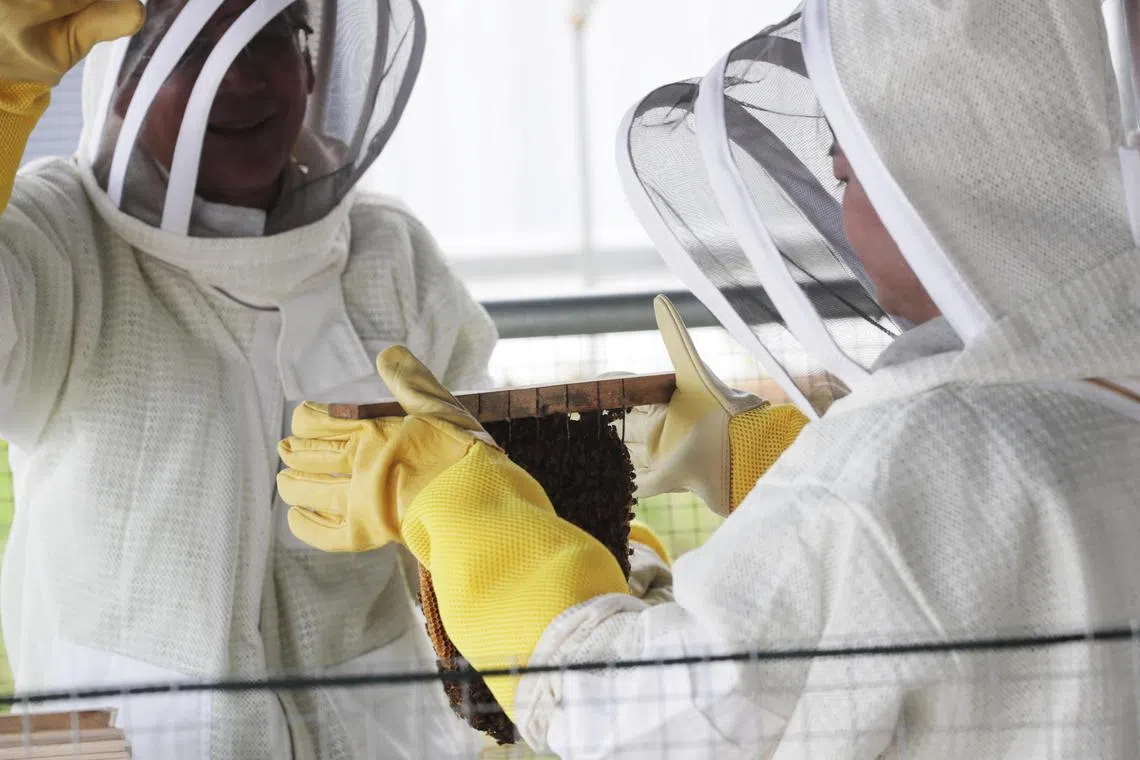
Ms Lim Li Shian had the chance to hold the honeycomb, under the watch of Mr John Chong.
ST PHOTO: KELVIN CHNG
Bees are key pollinators and honey producers, but their numbers have been declining globally, largely due to habitat loss and the use of pesticides.
Between 2016 and 2020, the National Parks Board received around 8,400 requests for the removal of bee, wasp and hornet hives.
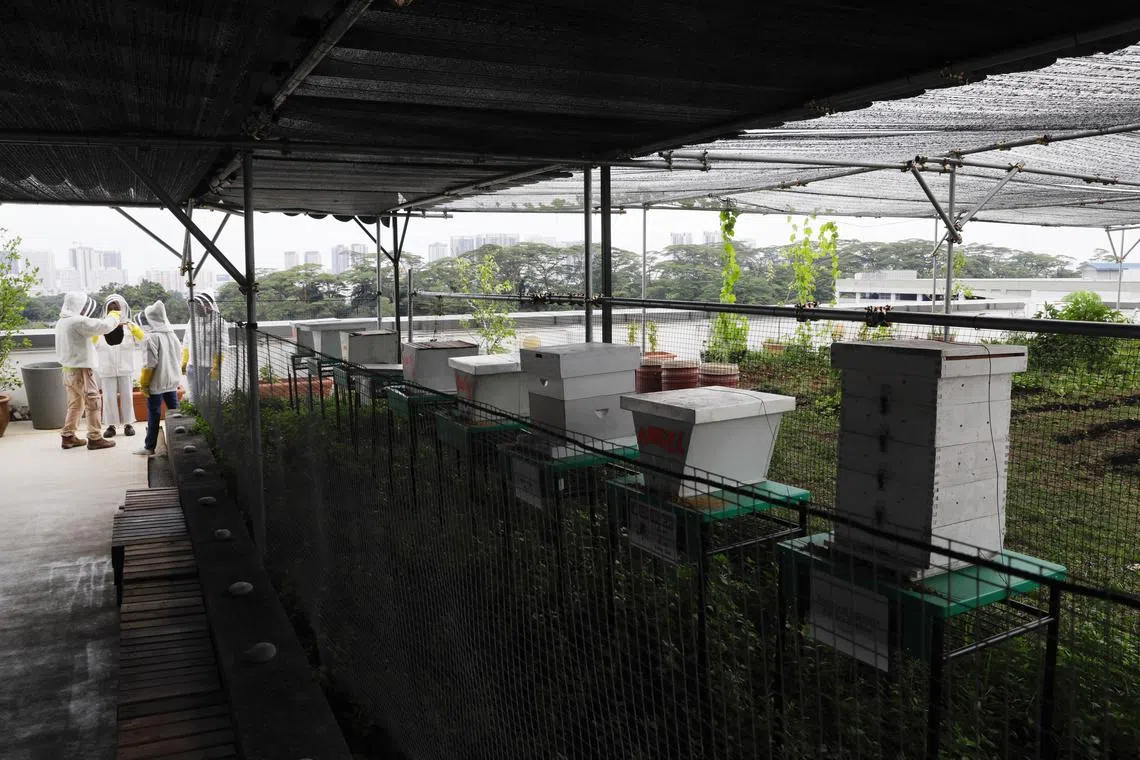
The manmade beehives on the SUSS rooftop farm. Some of the structures are empty in case wild colonies want to set up home.
ST PHOTO: KELVIN CHNG
The default method of managing hives is to exterminate them, but at least three bee rescue firms and a few pest control companies are looking to change that.
The Asian honey bee and the red and black dwarf honey bees can be relocated safely, since they attack only when their hives are threatened.
The giant honey bee, which at nearly 2cm can be twice the length of the Asian honey bee, is known to be aggressive and cannot be domesticated. They are either left alone or exterminated if their hives are located close to human traffic.

A honeycomb of Asian honey bees, the most common bee species in Singapore.
ST PHOTO: KELVIN CHNG
Mr Chong has set up other bee sanctuaries at the Sentosa Golf Club, a farm in Lim Chu Kang, and in private houses whose owners were keen to learn beekeeping.
Some of his rescued bees come from Origin Exterminators, where he trained pest controllers. Origin’s director Winston Baptista hopes that more clients will request that bees be relocated instead of killed.
“Even with our efforts in educating clients, it results in only one relocation with every five exterminations,” he said, as most clients prefer a quick fix and want the bees out of their property immediately.
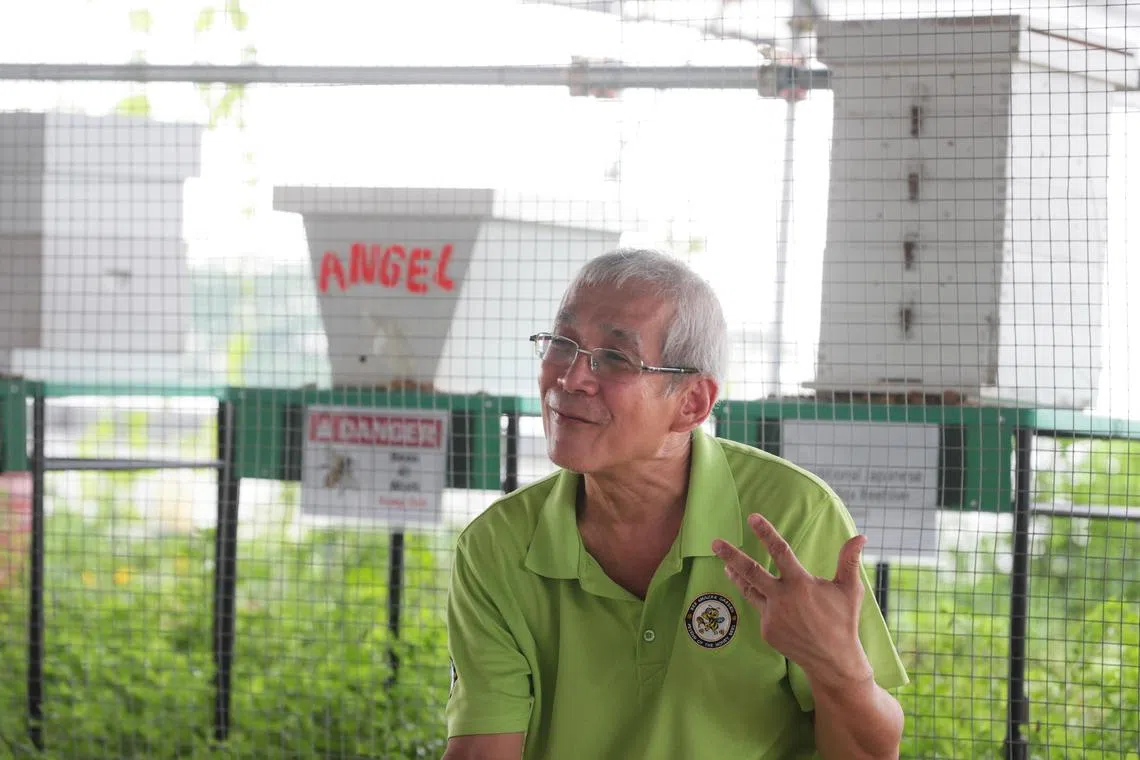
Mr John Chong, founder and beekeeper at Bee Amazed Garden.
ST PHOTO: KELVIN CHNG
It takes about 45 minutes to exterminate bees with a toxic chemical, but between 30 minutes and 10 hours to relocate bees based on the species and location of the hives.
Relocation services also tend to be costlier than extermination due to the required time, equipment, training, safety checks and delivery to the sanctuaries, said Mr Baptista.
While pricing differs across firms, bee extermination can cost around $150, with a relocation costing between $150 and $450.
Mr Clarence Chua, founder of The Sundowner Bee Rescue non-profit, has been able to offer his services to pest control companies at half the price after receiving a four-year $32,000 sponsorship from a global logistics firm and German foundation Stiftunglife.
In 2022, the non-profit carried out 88 rescues, up from about 30 the year before.
So far in 2023, there have been 75 rescues. Two of the organisation’s clients are the town councils of Ang Mo Kio and Jurong-Clementi.
Sundowner’s main apiary is on the roof of a Siglap shophouse where Mr Chua’s main business – The Sundowner Nature Experience Centre – is housed.
Visitors can try coffee roasting and pasta making, and get up close with bees, ants and earthworms.
The non-profit recently collaborated with Killem Pest, a pest control firm, to relocate two hives containing 40,000 Asian honey bees from The Singapore Association for the Deaf.
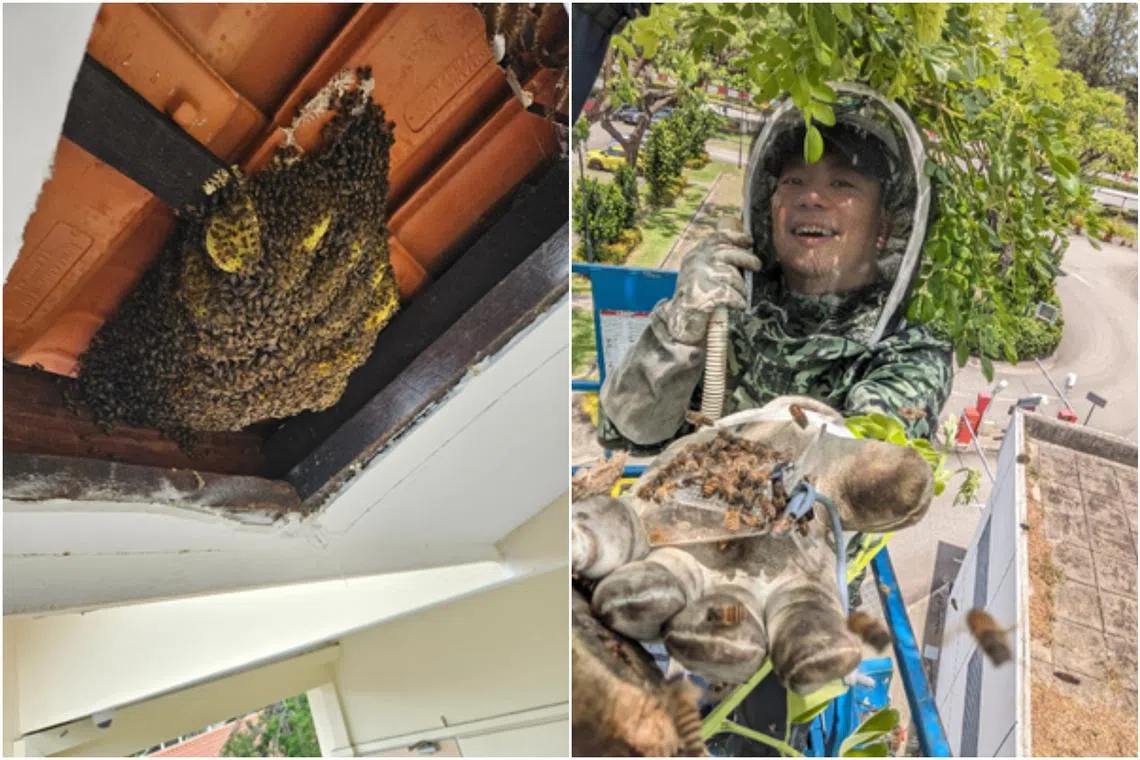
Part-time rescuer Eugene Goh helped to collect and relocate the bees found in The Singapore Association for the Deaf.
PHOTOS: THE SUNDOWNER BEE RESCUE
Killem Pest pivoted to rescues when one client, an international school, discussed relocation with the firm, said the firm’s managing director Nicole Zycinski-Singh.
While bee rescues and building sanctuaries are gaining traction, Mr Chong said having best practices guidelines can help avoid conflict between wildlife and humans.
He said: “The CET course I’m proposing is to teach trainees to do rescue work safely. For those with bee allergies, one bee sting can be fatal. I want everyone to be friends of bees, but I also want to err on the side of caution.”


